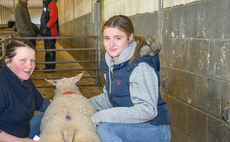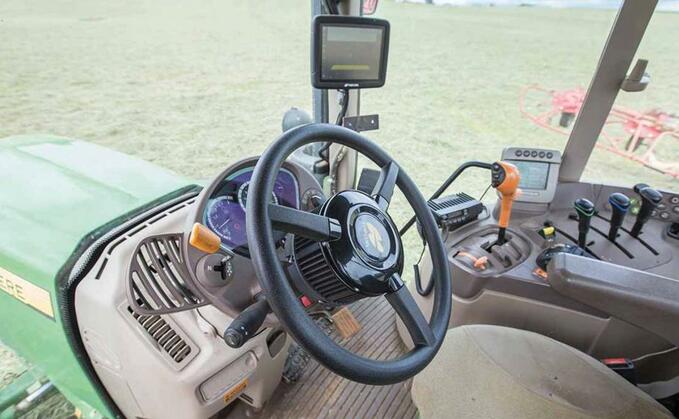
You do not have to buy a tractor which is ‘auto-steer ready' to take advantage of auto-steering capability.
Older tractors can be upgraded, as one Oxfordshire grower explains to Geoff Ashcroft.
Henry Taylor had been looking at auto-steering systems for a number of years, but was unconvinced about how to take the seemingly bold step without breaking the bank or straining his and his co-workers' brain cells learning complex new systems.
It was a dilemma compounded by running a fleet of older tractors which comprises a seven-year-old JD 6830, a 15-year-old JD 7810 and a 12-year-old Househam AR3000 self-propelled sprayer, none of which are even close to being ‘auto-steer ready'.
"We all like straight lines, and we all know we can drive straight, but there are some jobs, particularly when you move to wider kit, where an auto-steering system will help you be much more efficient pass-to-pass.
"I simply could not justify changing any of our tractors just for the same sized model, to get newer hardware and software. I wanted to find a cost-effective way of making an upgrade to tractors we already have."
Inputs
Henry had already tried an early light bar guidance system, but did not gel with the way it demanded constant steering inputs from the operator.
He says: "Rolling countryside, woodland and steeply sloping ground leave us with no phone signal on most of the farm, which creates a further problem with sim-based systems."
Not one to give up easily, he says he had been following many firms on social media, and in doing so, was keeping an eye on technology.
He says: "I really liked what LH Agro was doing with customers' kit. The specialist approach to precision farming equipment looked easy, and importantly, it looked easy to learn too. So I got in touch to see what might be possible for our situation."
Based at Blenheim Farm, Shutford, near Banbury, Oxfordshire, the family-run 220-hectare (550-acre) farm has been gradually shifting its rotation from an all-arable system to one which focuses more on grass to meet demand for high quality hay and forage.
It means 100ha (250 acres) of grass is supplemented by winter wheat and oilseed rape, which he views as break crops for grass leys.
Fieldwork is extensive, with a mix of soils including heavy clays, brash, iron stone and sand.
While the plough is rarely seen, most cultivations are min-till based and revolve around a 6.5-metre Wilrich cultivator, in combination with chain harrows, a 4m power harrow, 6.5m Vaderstad Carrier and a 4m trailed Vaderstad Rapid drill.
A 3m Sumo is hired-in for deep cultivations, as is half the outfit's mowing capacity.
He says: "The LH Agro team came and installed the unit to the sprayer. They also brought a wiring harness and fitted it to the 7810, along with a foot switch to activate the steering. Touching the steering wheel overrides the automatic steering.
"LH Agro soon established an RTK signal was available at the farm, so we bought into the signal for an annual fee.
We could have settled on a free signal, but there is no point coming out from trees and having to stop and wait for a signal. We wanted signal reliability right across the farm.
"Auto-steering is amazing, but I found myself having to nudge the sprayer to stay on our 24m tramlines. Six passes with a 4m drill using bout markers meant our tramlines were not quite as accurate as we had thought.
"Chris Limb at LH Agro convinced us to drop our tramlines from the drilling process and put them in with the sprayer. We used pre-emergence markers purely as a safety net until we could see the system does work."
Henry says eliminating tramlines has since helped with weed suppression across all crops, and the rake no longer finds dips in the ground where tramlines once existed.
He says: "There is no bare ground for weeds to grow in and we have reduced the risk of soil contamination while raking hay and forage crops."
Henry is so convinced on the merits of auto-steering, he has since invested in a second complete auto-steering kit, this time using a smaller X25 8.4in touchscreen.
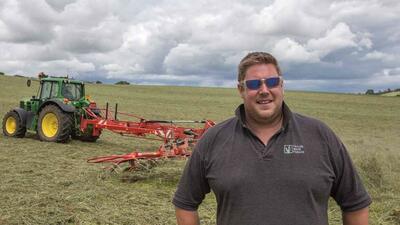
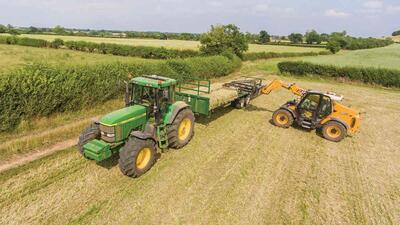
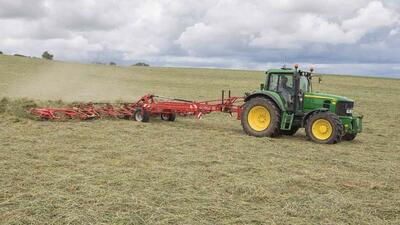
More
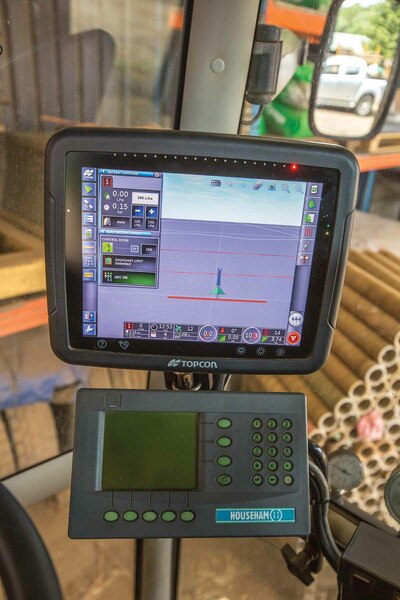
With some components sourced second-hand through LH Agro, including a third electric steering wheel and a used spray ECU for section control, the system's cost-effectiveness continues to improve.
The farm's JD 6830, JD 7810 and Househam sprayer now all run with their own Topcon AES25 electric steering wheels permanently installed.
Henry says: "We now have three electric steering wheels, two receivers and two screens. We can move the receivers and screens between vehicles, as and when they are needed. If auto-steering is on the tractor, it will be used."
He adds that while such a system might seem overkill when tedding or raking, the ease with which it operates makes life easier for him and his team.
Network
His dad John says: "I would not want to go away from automatic steering. Once I have got my network of lines for the right implement, I just need to tap the foot pedal to lock onto the signal and I can relax."
All tractors and implements are stored in the system and any of the farm's operators only need to select the kit in use and mark an A-B line on-screen.
Henry says: "It is just as good when drilling, although where it wanted me to drive on a slope to match up was not where I wanted to drive from experience, but the system is right.
"It takes into account the position of the implement from the tractor's receiver and it compensates for the distance behind the tractor and the gradient."
More 2

The arrival of the larger X30 screen, essentially for the sprayer, has also brought extra capability for Blenheim Farm.
Henry says: "We have further upgraded the sprayer to include auto-section control for the boom. We have gone from four manually controlled boom sections to eight automatically controlled boom sections.
"The engineers at LH Agro cleverly installed an auto-steering button on the joystick.
"With fields ranging from 3.5-27ha, we are now saving on chemical and fertilisers too. This year, none of our crops have lodged through overlaps."
Due to buying a combination of new and second-hand components, Henry reckons the farm has invested about £35,000 in auto-steering systems and associated control units over the last 18 months, as it gradually upgraded its two tractors and a sprayer to make the most of precision farming methods.
The only additional ongoing cost is a yearly subscription to an RTK signal service to allow two receivers to be used.
Henry says: "It has been money well spent and has proved much more cost-effective than swapping tractors which are auto-steer ready. We have become so much more efficient by making the most of every implement's working width and operating kit has become less tiring too.
"I just need to convince Jake Davenport of the merits of auto-steering so he can mow straight."
























